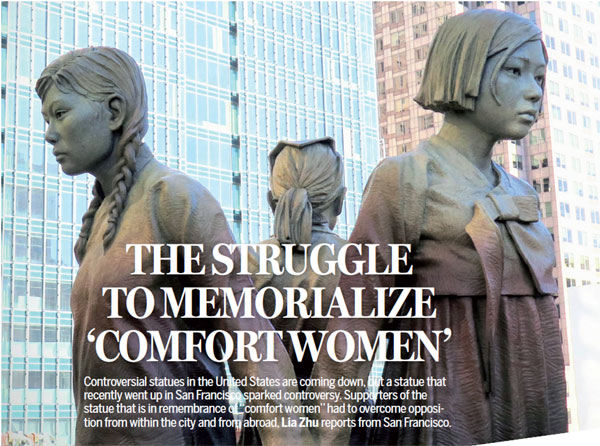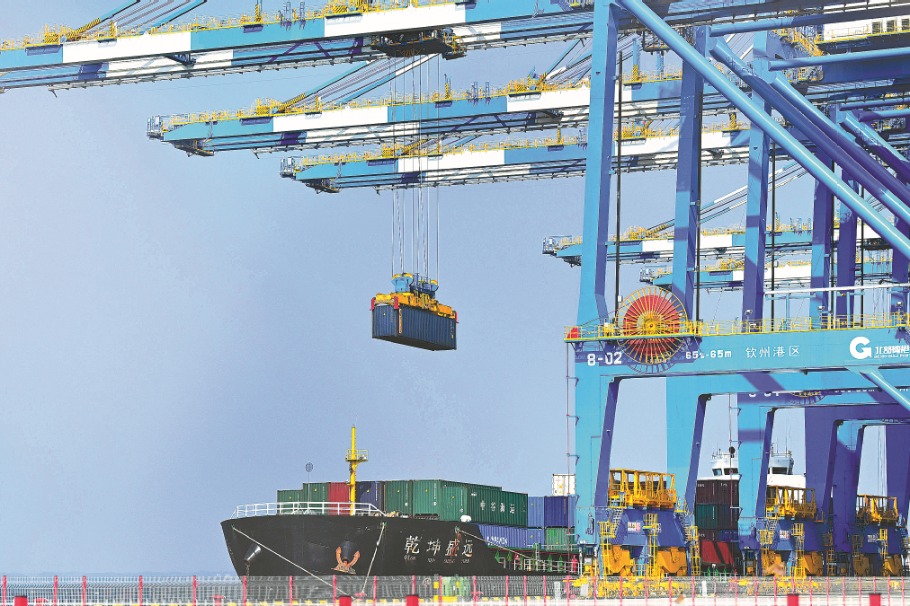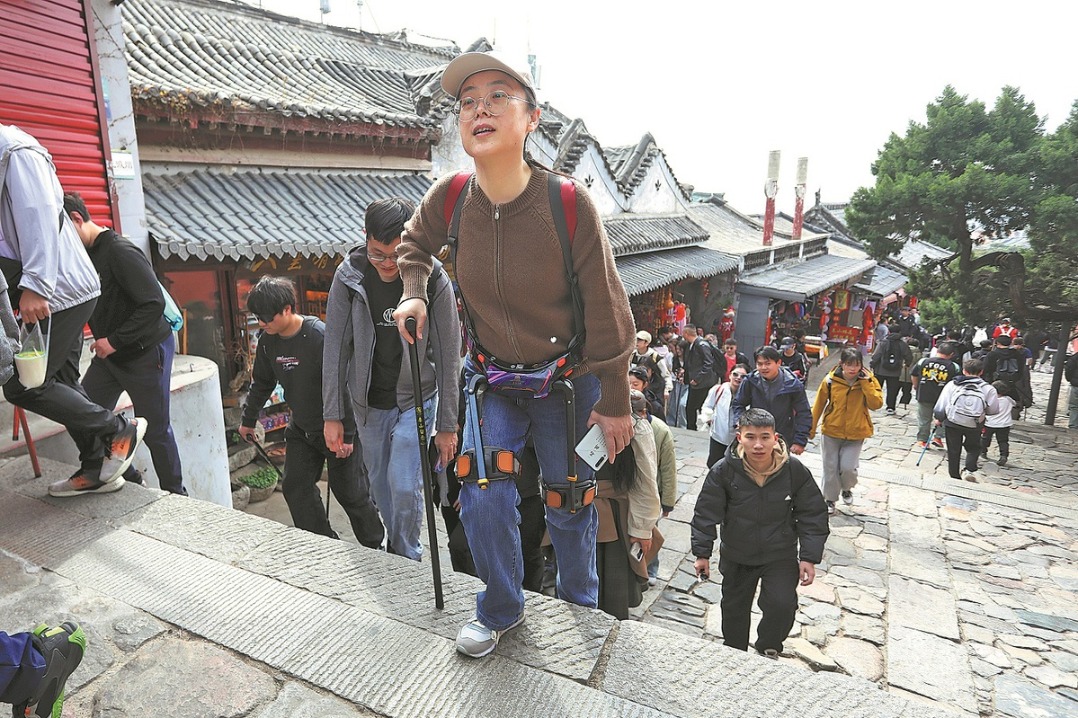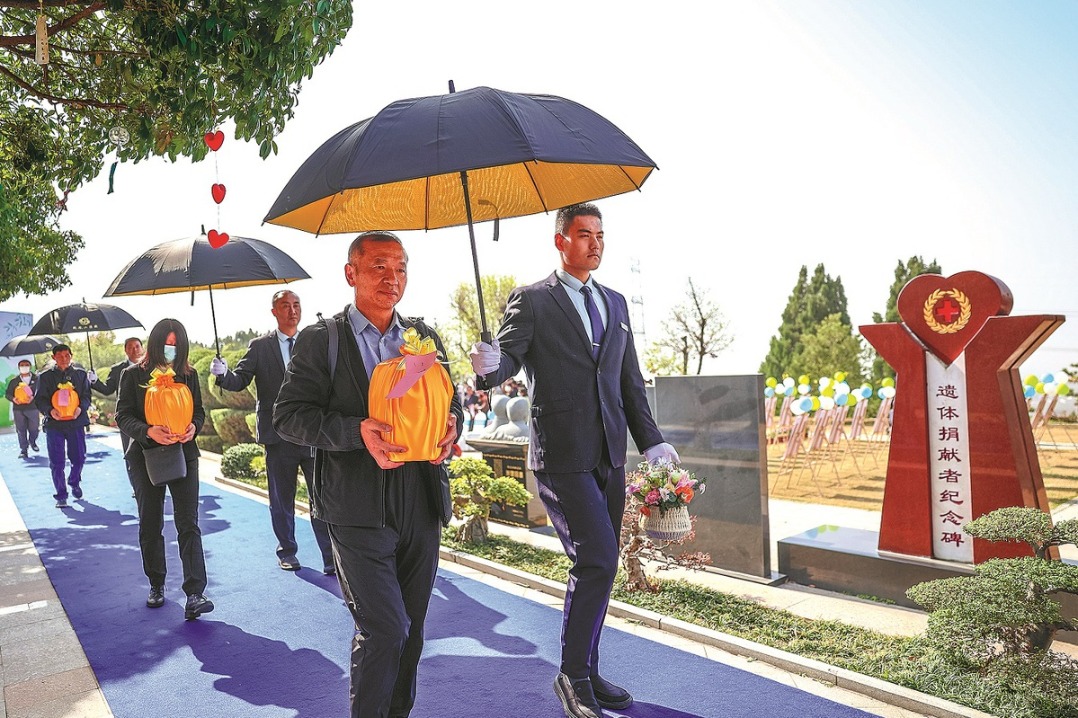The struggle to Memorialize 'Comfort women'
China Daily USA | Updated: 2017-12-04 14:42
Controversial statues in the United States are coming down, but a statue that recently went up in San Francisco sparked controversy. Supporters of the statue that is in remembrance of 'comfort women' had to overcome opposition from within the city and from abroad, Lia Zhu reports from San Francisco.
The afternoon autumn sun burst through skyscrapers, casting a golden glow on the statues of an elderly woman looking at three teenage girls holding hands atop a pedestal.
The three girls, Chinese, Korean and Filipina, represent hundreds of thousands of Asian girls and women who were forced into sexual servitude by the wartime Japanese military and euphemistically called "comfort women".
The statue of the elderly woman in Korean clothing symbolizes the survivors still hoping for justice. It is of Hak-soon Kim, the late "comfort woman" who in 1991 was the first woman to come forward about the plight of the "comfort women".
On Sept 22, the 10-foot statue - "Women's Column of Strength" -was dedicated on a terrace of a park next to St Mary's Square in downtown San Francisco to Asian "comfort women", the first of its kind in a major US city.
"It's like our child," said Lillian Sing and Julie Tang as they gazed up at the bronze statue by Steven Whtye.
The retired judges hadn't expected their privately funded two-year project for the statue would succeed amid a torrent of opposition and unexpected international attention.
The opposition
Sing and Tang's effort to educate the public to the atrocities committed by the Japanese Imperial Army started in 1998, when they co-founded the Rape of Nanking Redress Coalition in San Francisco to raise awareness of the Nanjing Massacre (also known as the Rape of Nanking) in 1937.
Japan's sex enslavement system was expanded from China in 1932 to Southeast Asia, involving 13 countries. An estimated 400,000 girls and women were forced into prostitution, half of them from China, 140,000 to 160,000 from Korea and the rest from Japan and other countries, according to Su Zhiliang, a history professor at Shanghai Normal University, who has spent more than two decades researching the "comfort women" system.
"The 'comfort women' issue has always been in the back of our mind," said Tang, who has been devoted to the project. "Every year, less and less 'comfort women' are alive. We felt that it's important to build a memorial right now or never."
The effort by the Chinese-American community with support from Korean, Japanese, Filipino and Jewish communities led to the establishment of the multi-ethnic Comfort Women Justice Coalition in 2015, co-chaired by Sing and Tang, both former judges of the Superior Court of San Francisco County.
In 2015, Eric Mar, a Chinese American, who was then on the San Francisco Board of Supervisors, proposed legislation to the board in support of the memorial.
"At that time, we hadn't realized what kind of forces were behind the opposition until we had a public hearing," said Sing, the first female Chinese-American judge in California who retired two years ago to concentrate on the project.
"Then we saw the opposition's hands. They were organized, they had busloads of people, they had letters written and they were lobbying the Board of Supervisors," she recalled.
Around 100 people, including Japanese Americans and Japanese nationals, testified against the memorial at a hearing on Sept 22, 2015. They argued that it would fuel anti-Japanese sentiment and single out Japan for public rebuke.
Among them was Janice Mirikitani, a longtime co-leader of Glide Memorial Church. During World War II, she was interned at a relocation camp with her family in Rohwer, Arkansas.
Though activists said Mirikitani had signed the resolution in support of the memorial before it went to the supervisors, she later spoke against it for fear of "anti-Japanese profiling".
Another opponent was Emily Murase, executive director of San Francisco's department on the Status of Women and president of the San Francisco Board of Education. "It's a scare tactic. These are the reasons they (Japan) want to scare the politicians - 'You are dividing the Asian community' - they pit us against each other," said Sing.
During the hearing, the supervisors heard from Yong-soo Lee, an 87-year-old "comfort woman" survivor, who flew into San Francisco from Korea to call upon the supervisors to install the memorial.
Koichi Mera, a "comfort women" denier and plaintiff in a lawsuit against a "comfort women" memorial in Glendale, California, called Lee a "prostitute" in front of the board of supervisors.
"Shame on you," the supervisors responded to the personal attack on Lee.
The supervisors unanimously passed the resolution, but opposition to the memorial didn't stop. The San Francisco Arts Commission received more than 200 emails early this year, mostly from Japan, in opposition to the statue's installation.
Whyte, the sculptor selected by the commission to create the comfort women statue, said he received more than 1,000 social-media messages and emails demanding he stop work on the project and threatening boycotts of his work.
The message
"If that (opposition) was successful, we would never be where we are today," said Sing. "So we realized how much we need to focus on the theme - women's and human rights. We need to make sure people understand that we are not against Japanese Americans, but what Japan did during World War II - kidnapping, slaving and raping girls and women."
Thanks to decades of connections with members of the Japanese community, Sing and Tang garnered a lot of support for the statue.
Fred Korematsu, a civil rights activist who defied the internment of Japanese Americans during World War II, was honorary chair of the Rape of Nanking Redress Coalition when he was alive. His daughter Karen Korematsu is honorary co-chair of the Comfort Women Justice Coalition. Jeff Adachi, the public defender of San Francisco, also spoke in support of the memorial.
Grace Shimizu, a Japanese-American supporter, said in a letter to the San Francisco Chronicle published on Oct 14, "I gain inspiration and strength from this beautiful memorial. It speaks to the power of people in the US, Japan and around the world as we are joining hands and organizing together for peace and to resist denial of history, cover-up of state responsibility and rising violence against women and children by right-wing nationalists."
The advocates stressed that the "comfort women" issue isn't just about some wrongdoing that happened 80 years ago in Asia; sex-slavery and human trafficking is a universal issue that is happening right now, from Sudan, Bosnia, Congo to groups like Boko Haram.
"Japan was the first country in modern history to sex-traffic such an unprecedented volume of women all over Asia, and history is being repeated right now," said Tang.
"Rape is the only crime in which the victims feel shamed and guilty. So when these women came out and talked about it, we honor them," she said."That's why the 'comfort women' issue is so important. The memorial is a victory to all women who can now speak out and tell what happened, not feeling shamed."
Since the horrific stories of "comfort women" were told publicly in the 1990s, about 50 memorials have been dedicated to the women around the world. The San Francisco memorial is the first to commemorate three countries.
"This is a global message to the world that women will not be silenced. This is a victory distributed from San Francisco, the United States, throughout the whole world," said Tang.
International attention
In September, the Chronicle published a letter from Japanese Consul General in San Francisco Jun Yamada in which he called the statue a "half-told" story. The mayor of Osaka, Japan, threatened in a letter to the mayor of San Francisco to sever the 60-year-old sister-city relationship if the statue was made public.
"In law, the best evidence is the testimony of victims or witnesses, not the writings or speeches by politicians," said Sing. "Japan made a 'big mistake' by turning it into an international issue, where people start paying more attention to it."
During the statue's unveiling ceremony on Sept 22, the 6,000-square-foot terrace where the statue was installed was packed with visitors and journalists.
The Glendale lawsuit seeking the removal of a "comfort women" statue in the small city also helped garner the international attention.
The lawsuit went to the US Supreme Court in January and the Japanese government filed an amicus brief, saying the statue concerns Japan's "national core interest" and disrupts "Japan's delicate relations with Korea".
The high court in March declined to hear the case, and the statue, which depicts a Korean girl sitting next to an empty chair, remains in place.
"We have the most powerful weapon, which is justice," said Phyllis Kim, a "comfort women" advocate and a major force behind the Glendale memorial.
However, her efforts to raise another statue in Atlanta, Georgia, failed as the Center for Civil and Human Rights canceled the plan to install the memorial this spring.
Activists believe the Japanese government exerted pressure on the center by threatening that Japanese businesses might leave Atlanta if the memorial were placed in the city.
"I'm not disappointed or pessimistic at all," said Kim. "When we reach out to people and present photos and testimonies of grandmas ('comfort women' survivors), they choose to stand with historical truth."
Sing and Tang said they were glad to see that comments from the public are mostly against the Japanese position.
"I'm surprised that in these two years so much attention has been paid to the 'comfort women' memorial. We have opened up the mainstream's consciousness to this issue for the first time in the US by putting up the memorial," said Tang.
She likened their fight of the memorial to the battle of David against Goliath.
"We are the little David. We had a budget of $500,000, while their budget is $500 million. Our budget was to build a memorial and educate the public; their budget was to downplay the Rape of Nanking and 'comfort women' issue," said Tang.
"We won the 'battle' fair and square. But we haven't won the 'war' - they still have not apologized, and they still have not atoned for their crimes," she said.
Going public
The activists tried to preserve the authentic costumes for the statue to represent the history when these events occurred. They researched and found actual clothes worn by women during that period.
Though supporters of the statue had beaten the opposition, the struggle to erect the statue had not ended. The next problem was finding a site, because virtually every inch of public land has been taken in the crowded city. Several places were considered, including the Golden Gate Park, Legion of Honor, Moscone Center and Yerba Buena Gardens. Eric Mar and members from different communities studied locations.
The group finally focused on St Mary's Square, but the park is going through a four-year master plan, which meant the memorial would be built in four years. "We can't wait. The 'comfort women' are dying," said Sing.
Then they were told that a 6,000-square-foot private plot, a terrace next to the public park, would be deeded to the city in exchange for allowing developers to construct a building. On Oct 18, the terrace was integrated with the park, and the statue has since been visible to the public.
Contact the writer at liazhu@chinadailyusa.com

The “comfort women” statue “Column of Strength” at the St. Mary’s Square in San Francisco. LIA ZHU / CHINA DAILY
























